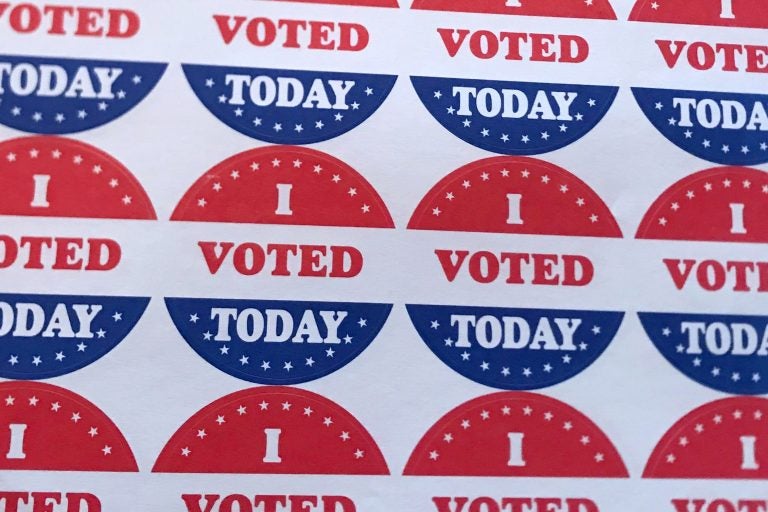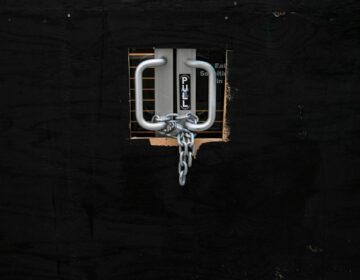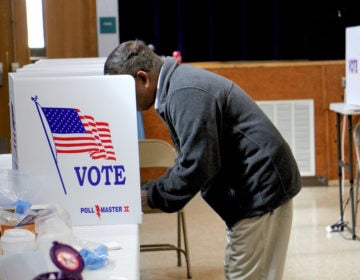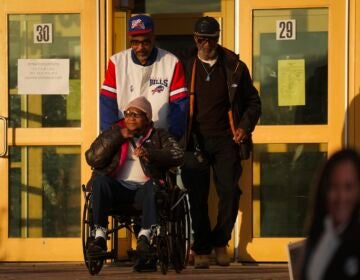How to vote in Pennsylvania during a pandemic
Officials are scrambling to adapt the June 2 primary to a new, coronavirus-induced reality. Unknowns remain, but here’s a guide to navigating the process.

(WHYY)
Pennsylvania is rolling out a number of major election changes for the June 2 primary — including an expansion of its vote-by-mail options. After state law changed last year, voters no longer need an excuse to vote by mail, and have more time to return their ballots.
These historic changes created more flexibility in an election code some had long derided as unnecessarily restrictive. And it was especially significant given the timing: Gov. Tom Wolf signed the law in October 2019, making the 2020 primary the first election under the new rules.
From the start, officials worried about implementing new policies during a presidential election year. Already, more than one third of counties were planning to debut new voting machines for the primary. Elsewhere, machines would be new to voters who hadn’t turned out for 2019 elections.
And that was all before the new coronavirus hit.
With COVID-19 on top of everything else, election officials predict a “perfect storm” that will overload counties, delay results and potentially disenfranchise voters.
Concerns about virus transmission have fundamentally changed how Pennsylvania’s presidential primary will work. From scrambled polling places to brand-new deadlines to potentially waiting days for final results, here’s what to expect on primary day.
When to vote
Pennsylvanians had until May 18 to register to vote. Thanks to the passage of Act 77 last fall, that was two weeks later than normal.
They had until May 26 — a week before the primary — to request a ballot. To do that, they needed their driver’s license or Social Security number; however, Pennsylvania voters no longer needed an excuse to get an absentee ballot. They have until polls close at 8 p.m. on primary day to get the ballot back to their county elections office (also new under Act 77).
If voters don’t postmark their ballots in time, they can drop them off in person.
The state Supreme Court has dismissed a lawsuit challenging the return deadline, one of three court actions seeking to move it to June 9 so long as ballots are postmarked by Election Day. An emergency petition brought by Montgomery County May 26 was rejected by a county judge within 24 hours of being filed. One lawsuit remains pending in Commonwealth Court.
Why does the state want you to vote by mail?
When lawmakers began assembling a legislative response to the coronavirus this spring, one of their first orders of business was to move the primary from April 28 to June 2. The idea was that COVID-19 infection rates would probably be lower in June, which would make in-person voting a less risky proposition. Plus, a delay would give county election offices — which are responsible for on-the-ground voting operations — more time to adjust.
Voters who applied for mailed ballots before the primary date shifted won’t be affected by the change or have to reapply. They’ll receive ballots along with everyone else, and will be able to submit them for the new election date as they normally would.
Public officials in Pennsylvania and other states are now espousing a similar rationale in pushing for vote-by-mail: that it’s safer from a public health perspective, for both voters and poll workers.
Before the pandemic, mailed ballot use was expected to increase between 15 and 20% over the last presidential election, merely because voters — no longer needing a medical, work-related or similar reason for not going to the polls — might find it more convenient.
Now the number has skyrocketed. More than 1.8 million Pennsylvanians have applied to vote by mail, according to numbers provided May 27 by the Department of State.

Your go-to election coverage
How and where to vote in person
A handful of counties will cut in-person voting locations by more than half for the June 2 primary: Allegheny, Delaware, Montgomery, Philadelphia and Luzerne.
At least a dozen others are planning reductions that, while minimal, mean voters still need to double-check their polling place. And still more are moving voting venues for reasons unrelated to the pandemic.
Pennsylvanians who are voting in person should double-check their polling places via their local county elections office website. You can find the links in this interactive map, which also has phone numbers to call for voters who have questions or concerns about mail-in ballots.
Erie, Allegheny and Philadelphia and its collar counties also have location information for drop boxes for voters concerned that their ballot won’t make it back through the mail before 8 p.m. June 2.
The vast majority of counties will notify voters of changes directly by mail, post new site information at the old spot or both; however, some lagged in updating The Department of State’s polling place locator.
Normally, the law requires counties to directly notify voters of polling place changes, post the new address at the old spot and adhere to a public process that includes court oversight. None of that is required under rules meant to apply only to the 2020 primary, though counties must post the updated polling place plan on their websites and at their main elections offices.
The temporary rules also let counties cut the number of voting locations by as much as 60%. More drastic reductions require a waiver from the Department of State.
Public schools dominate the new, pared-down lists because state law requires them to host voting if asked. They’re also closed and will be for at least for the rest of the academic year, eliminating risks that would be presented by facilities still in use, even if in a limited capacity.
Asked why the state isn’t permitting counties to switch to fully vote-by-mail elections, Pa. Secretary of State Kathy Boockvar said they would almost certainly run into legal issues.
Federal law, she said, requires states that conduct mail-only elections to have voting options that are friendly to certain people with disabilities, such as the blind, who might struggle to fill out a paper ballot without help.
She noted that Pennsylvania got a federal grant to implement some of those disability-friendly mail options for November’s general election, but the capability won’t be there for the primary.
Boockvar also thinks an all-mail primary might end up confusing — and thereby disenfranchising — some voters.
“There’s not enough time to really ensure adequate participation in our democracy by vote-by-mail alone,” she said. “That’s why we’re really looking at this as a multi-front approach.”
Those are some of the same reasons that even vote-by-mail states (Hawaii, Oregon, Washington, Colorado and Utah) run centers for early in-person voting and/or ballot dropoff. However, those states automatically send ballots to all registered voters. Some others — including Ohio, Connecticut and Rhode Island — turned to a “limited mail” set up in response to the public health crisis that entails automatically mailing ballots to registered voters and opening relatively few polling places. New York is sending vote-by-mail applications while largely maintaining in-person voting.
Pennsylvania didn’t take it that far, despite demands from a substantial number of county election directors.
Along with Boockvar’s concerns about legality and a tight timeline, state officials and lawmakers worry that voters might be confused about how to account for mailed ballot applications already in process. Others fear outdated registrations could lead to ballots being cast by someone other than the intended recipient.
What could go wrong?
The chief concern among state and county officials — particularly for hard-hit regions, like the southeast — is that people who work the polls and vote in person will get sick.
The Department of State plans to help out with supplying masks, gloves, disinfecting wipes and other personal protective equipment, or PPE. At least 20 counties said they were concerned they won’t have enough supplies, however, even with state assistance.
Counties had started receiving state-issued supplies during the week or so prior to the primary and expected to have their full shipment in house by May 29.
Others say they’re fully stocked on their own, with some acquiring plexiglass dividers to shield voters and poll workers at voting locations. And special elections March 17 afforded a practice run in a few jurisdictions.
A more universal fear: Mailed ballots overwhelm the state’s election system.
Counties recently asked state lawmakers to change the election code to allow them to start processing returned ballots a week or two before the primary. They say that would at least help minimize delays in finalizing results. Legislators say they won’t take up the issue again, however, until after the primary.
Some counties already ordered extra equipment last fall after voters no longer needed an excuse to vote by mail, with another round of purchases made amid the pandemic.
Others — including Chester, Mercer and Lycoming — have signed last-minute contracts with mail processing businesses. Officials say the agreements will help avert catastrophic ballot application backups; however, the deals came together faster and with (even) less public oversight than usual, thanks to emergency bid and contracting provisions.
Then, there’s the challenge Pennsylvania’s been facing all along, before the pandemic or even last fall’s election code overhaul: new machines.
Twenty-two of 67 counties had planned a primary debut of new election systems that they all were required to purchase by the end of 2019 and launch before the November 2020 election. Some completed at least some poll worker training before the pandemic shuttered typical venues or rendered them unusable due to social distancing directives. Others managed to shift to training remotely or in extremely small groups.
Delaware County opted to majorly change its plans, partly because their poll worker pool is too vast for small-group or virtual instructions to work, officials said. So, now, the plan in the state’s fifth-most populous county is to collect hand-marked ballots in secure boxes and count them at the central office after polls close.
The majority of counties already used their new voting machines at least once; however, those were during off-year elections when turnout is low. Many voters will be using a new machine for the first time in 2020.
Most counties (51) also opted for hand-marked paper ballots, but the rest went with electronic voting machines. In response to COVID-19, hand-marked counties are planning to give every voter a fresh pen instead of reusing them. It’s a bigger challenge to make touchscreen systems sanitary, in most cases. Officials say that touchscreen machines do work when the voter wears latex gloves. So far, two counties plan to provide Q-tips for voters to use with their ExpressVote touchscreens from Election Systems & Software. But Q-tips aren’t compatible with all ballot-marking devices — including the ExpresVote XL, another ES&S machine being used by Philadelphia, Cumberland and Northampton counties. Philly officials say they’re exploring other options, including using a stylus. Union County’s planning to sanitize screens between voters. That could work for polling places serving relatively few voters, but could be time consuming enough over the course of many hours to cause long waits in busier precincts.
Three counties — Luzerne, Erie and Crawford — abandoned ballot marking devices altogether due to the pandemic and will instead use their Dominion Voting machines to scan hand-marked ballots.
WHYY is your source for fact-based, in-depth journalism and information. As a nonprofit organization, we rely on financial support from readers like you. Please give today.





![CoronavirusPandemic_1024x512[1]](https://whyy.org/wp-content/uploads/2020/03/CoronavirusPandemic_1024x5121-300x150.jpg)


